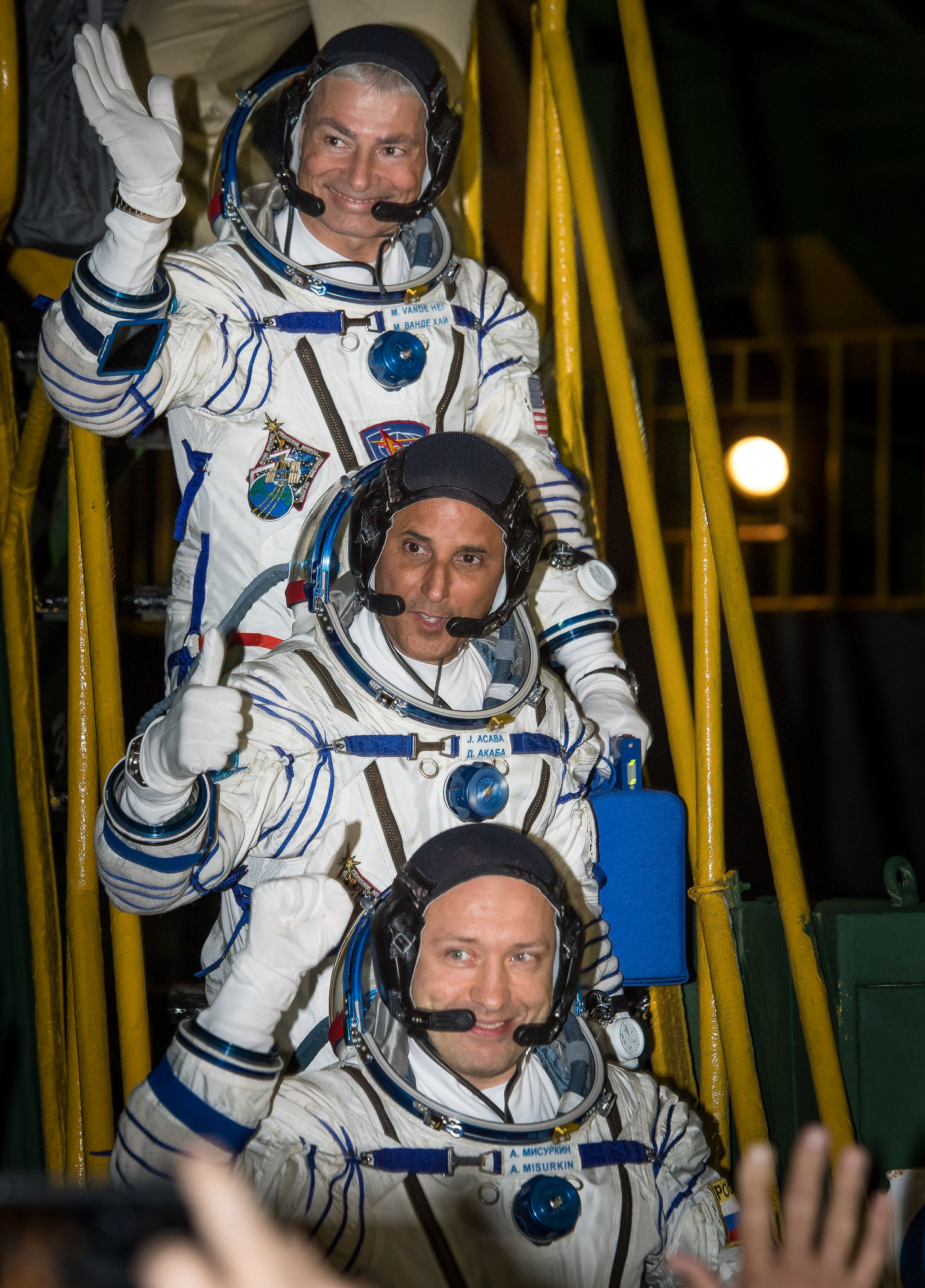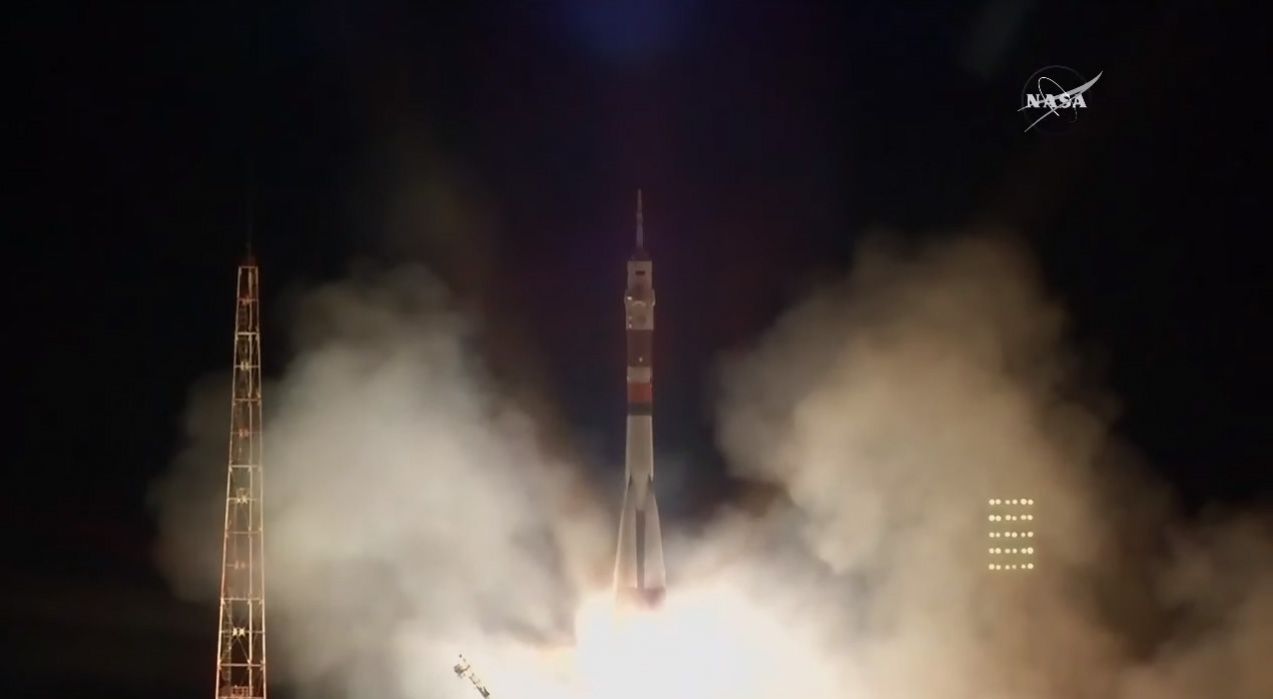US-Russian Crew Arrives at Space Station After Quick 6-Hour Trip
Update: The Soyuz MS-06 successfully docked at the International Space Station's Poisk module at 10:55 p.m. EDT (0255 GMT) after a nearly six-hour flight.
Two NASA astronauts and one Russian cosmonaut successfully launched toward the International Space Station (ISS) Tuesday (Sept. 12).
NASA astronauts Mark Vande Hei and Joe Acaba and Russian cosmonaut Alexander Misurkin blasted off atop a Russian Soyuz rocket from the Baikonur Cosmodrome in Kazakhstan at 5:17 p.m. EDT (2127 GMT). Packed tightly inside their Soyuz MS-06 space capsule, the trio began their 6-hour trip to the ISS after a flawless launch sequence.
"Everything is nominal on board [and] the crew is doing fine," a translator for Russia's Mission Control Center in Moscow repeatedly announced during a live webcast as the Soyuz MS-06 soared into the sky.
The Soyuz arrived at the space station's Poisk module a couple minutes early on Tuesday, at 10:55 p.m. EDT, 5 hours and 38 minutes after the launch (0257 GMT on Sept. 13). "A series of burns over the next several hours will gradually raise their orbit as they chase down the space station," NASA TV commentator Rob Navias said during the launch.
At the station, they will meet up with the other half of Expedition 53, three crewmembers who arrived at the ISS in July: NASA astronaut Randy Bresnik, Russian cosmonaut Sergey Ryazanskiy and European Space Agency astronaut Paolo Nespoli. Before they open the hatch, the crew will spend about an hour and a half performing a series of tests and checks on the Soyuz. The hatch is scheduled to open early Wednesday morning (Sept. 13) at about 12:40 a.m. EDT (0440 GMT), and a welcoming ceremony will follow. [Space Station Photos: Expedition 53 Mission Crew in Orbit]

Vande Hei, Acaba and Misurkin will spend about five months aboard the orbiting laboratory, where they will work on "hundreds of experiments in biology, biotechnology, physical science and Earth science," NASA officials said in a statement. They will serve as members of both Expeditions 53 and 54 during their stay.
Get the Space.com Newsletter
Breaking space news, the latest updates on rocket launches, skywatching events and more!
While Acaba and Misurkin have been to space before, this is Vande Hei's first time in space. Vande Hei, who was selected for NASA's astronaut corps in 2006, has served as an aquanaut aboard NASA's Aquarius underwater laboratory during the NEEMO 18 mission.
Both Acaba and Misurkin have flown to the ISS before; Misurkin served as a flight engineer during Expedition 35/36 in 2013, and Acaba was a flight engineer for Expedition 31/32 in 2012. Acaba also flew on the space shuttle Discovery for mission STS-119 in 2009, and has logged a total of 138 days in space between the two missions. In total flight time, Misurkin is the most experienced, with 166 days spent in space so far.
Originally, NASA and the Russian space agency Roscosmos planned to launch only Misurkin and Vande Hei on this particular Soyuz trip. Though the Soyuz has three seats, Roscosmos decided to cut one cosmonaut post in 2016 pending the construction of a new module. To maintain a crew of six people aboard the space station, NASA extended astronaut Peggy Whitson's stay by three months.

In February, NASA signed a contract with Boeing that would allow the space agency to fill two seats on Russia's crewed Soyuz flights, including today's launch and the Expedition 55/56 launch scheduled for March 2018. Boeing had obtained the seats as part of an unrelated settlement with Energia, the Russian company that builds the Soyuz spacecraft, and sold them to NASA for $373.5 million, or about $74.7 million per seat, NASA officials said in a statement. Under its regular contract with Roscosmos, NASA spends about $81.7 million per seat on a Soyuz.
Email Hanneke Weitering at hweitering@space.com or follow her @hannekescience. Follow us @Spacedotcom, Facebook and Google+. Original article on Space.com.
Join our Space Forums to keep talking space on the latest missions, night sky and more! And if you have a news tip, correction or comment, let us know at: community@space.com.

Hanneke Weitering is a multimedia journalist in the Pacific Northwest reporting on the future of aviation at FutureFlight.aero and Aviation International News and was previously the Editor for Spaceflight and Astronomy news here at Space.com. As an editor with over 10 years of experience in science journalism she has previously written for Scholastic Classroom Magazines, MedPage Today and The Joint Institute for Computational Sciences at Oak Ridge National Laboratory. After studying physics at the University of Tennessee in her hometown of Knoxville, she earned her graduate degree in Science, Health and Environmental Reporting (SHERP) from New York University. Hanneke joined the Space.com team in 2016 as a staff writer and producer, covering topics including spaceflight and astronomy. She currently lives in Seattle, home of the Space Needle, with her cat and two snakes. In her spare time, Hanneke enjoys exploring the Rocky Mountains, basking in nature and looking for dark skies to gaze at the cosmos.









